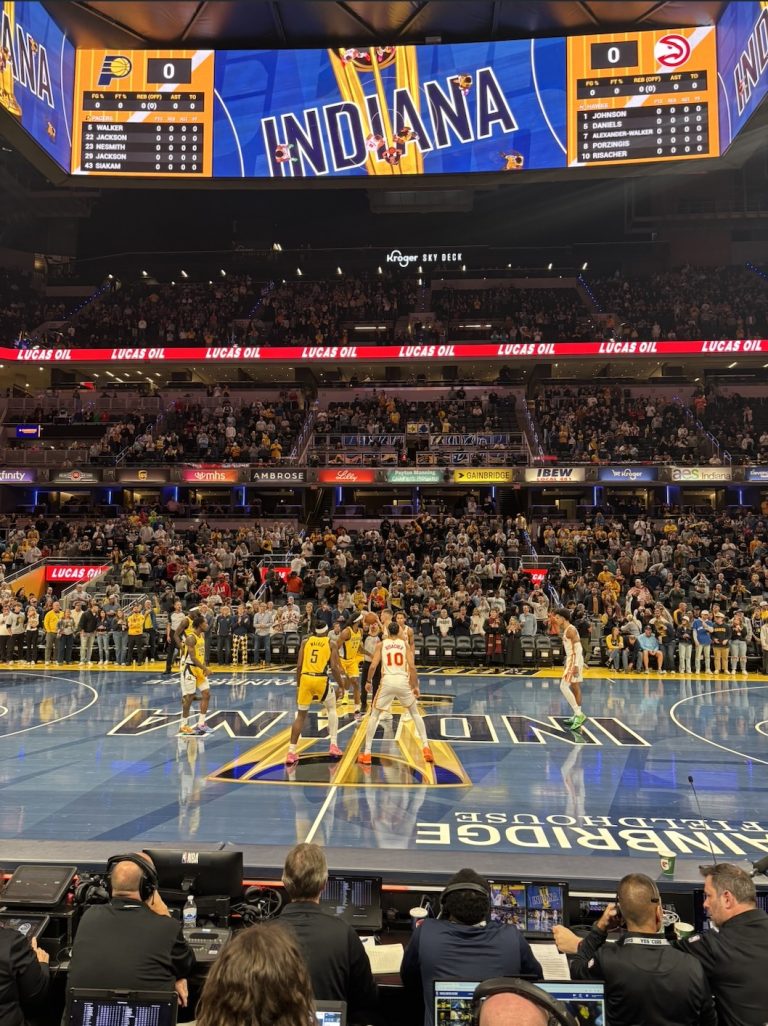
“Strata: Light, Sound, Sculpture” is a collaborative installation by University of Indianapolis alumn Quincy Owens and Ball State University alumn Luke Crawley that opened on Aug. 28. The installation will remain in the Christel DeHaan Fine Arts Center Gallery until Sept. 29.
The word “strata” refers to a layer or a series of layers in rocks or within structures. Owens and Crawley used the concept of strata in each of their pieces to showcase a variety of materials. Crawley worked with the sound and concrete sculptures in the gallery while Owens worked with the light, plastic and wire elements. Senior pre-art therapy major Nicole Hopf attended the opening showcase of the gallery.
She said that coming back to the gallery alone the following week helped her to better understand the artwork.
“The music is playing, and it goes with the lights, and then the lines draw you to other pieces across the room,” Hopf said. “It wraps around the whole space. It makes you move around it, and it makes you look at everything and gets all of the senses. Not only are you seeing all of these cool things, but there’s light, there’s sound, there’s color… there’s so many elements and principles that are tied into that that I didn’t know could be all tied together.”
Crawley said that he and Owens hoped to create pieces that viewers could interact with and react to in the exhibition.
Sparking curiosity and allowing viewers to come up with their own interpretations were also some of their goals for the installation.
“We always hope to make work that at least leads to curiosity,” Owens said. “With the light—and especially with shifting light and the sound, people just look at it. [We] just [want them] to stare and wonder why the different colors are changing and think, ‘Oh that used to be red, why is it black now?’ Things like that.”
The usage of different media is a common element in Owens and Crawley’s collaborations. The two met about 10 years ago while teaching at Herron High School; Crawley taught science, while Owens taught art. Overlapping themes in their classrooms eventually led to their collaboration.
“It was all very coincidental, but I would do these weird little one day sculpture assignments,” Owens said. “I was teaching them about different principles and then the kids one day were like, ‘Oh, we just learned about that in Mr. Crawley’s class!’ and then I had a light go off because I probably ought to go talk to that guy.”
Owens started incorporating physics concepts into his classroom to help reinforce the students’ learning. This collaboration led to Owens asking Crawley to help him on a deconstructed piano piece for the American Pianists
Association. Since then, the two have continued to work together, finding ways to bring science, art and music together.
“It’s always interesting to try and combine science and art authentically. That’s good for both sides,” Crawley said. “Often we see it where one of the sides is a little bit lacking. We try to have both the art side and the science side be pretty good.”

Crawley continues to teach science and math at University High School in Carmel, Ind. but Owens stopped teaching to pursue public art full time. That was one of the reasons the Department of Art and Design asked him to do an installation, according to Professor of Art Mark Ruschman.
“It’s about students actually seeing a graduate from UIndy come back who has been successful in the art world,” Ruschman said. “It’s somebody that they can hopefully emulate and relate to and learn from their [Owens’ and Crawley’s] experiences.”
Hopf and junior art therapy major Reagan Moorman both agreed that Owens’ ties to UIndy made the gallery more interesting and inspiring.
“It was more relatable because you saw where his roots were and you’re like, ‘Oh, that’s where my roots are. Maybe I can be like him,’” Hopf said.
Seeing Owens’ success as a public artist was encouraging for Moorman, who also has concentrations in studio art and ceramics.
“Everyone has that idea of the ‘starving artist,’ but this is just proof that that’s not necessarily true,” Moorman said. “It’s like a way of life, and grabbing those opportunities is how you succeed.”
During Owens’ 11 years as an undergraduate student, he showed one piece of artwork in the gallery during the Department of Art and Design’s accreditation process. Now, with the whole gallery full of his and Crawley’s collaboration, Owens said that having an exhibition at his alma mater was the pinnacle of his success.
“I don’t get teary-eyed on the outside, but this is a major, major homecoming,” Owens said. “This was an awesome [homecoming and a] place I’ve always wanted to exhibit. Better yet, we get two sculptures that are going to be permanently installed on campus, so we’ll always be here, which is super cool.”
Owens and Crawley encourage students to experiment with new materials in their art. This resonated with Hopf and also inspired her to collaborate with other artists.
“I feel like when you work with someone else, they can catch your mistakes. They know people that you don’t know, you know people that they don’t know,” Hopf said. “Just working together with someone you could really push your career forward. Everyone can semi-paint a picture, but not everyone can tie four different subjects into one piece.”
Owens’ and Crawley’s “Strata: Light, Sound, Sculpture” is the first of six galleries to be exhibited in the 2017-18 school year. The next exhibition is “Social Practice Art, a multi-disciplinary installation with a social and cultural focus and an emphasis on inspiring the community to create art outside of classrooms and studios. The exhibition opens on Oct. 9.






